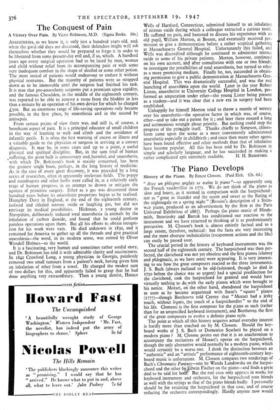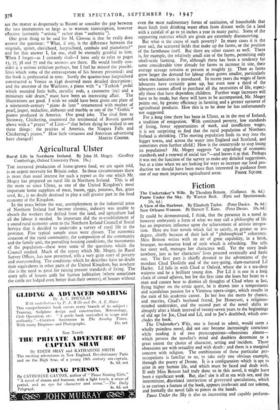The Piano Develops
History of the Piano. By Ernest Closson. (Paul Elek. .12s. 6d.)
" Avec un phlegme anglais se traine le piano "—so apparently sang the French vaudevillist in 1771. We do not think of the piano as slow and heavy, as it seemed in comparison with the harpsichord : nor as "great as thunder and the storm and sweet as the fluting of the nightingale on a spring night" (Rossini's description of a Stein- way piano, produced as an advertisement by the firm at the Paris Universal Exhibition of 1867). Perhaps the piano music of Hinde- mith, Stravinsky and Bartok has conditioned our reaction to the instrument and we have returned to thinking of it as predominantly percussive. M. Closson's book is almost entirely factual and to a large extent, therefore,- technical but the facts are very interesting and the more abstruse technicalities (escapement actions and the like) can easily be passed over. The crucial period in the history of keyboard instruments was the second half of the eighteenth century. The harpsichord was then per- fected, the clavichord was not yet obsolete and the first pianos (clumsy and phlegmatic, as we have seen) were appearing. It is very interest- ing to see how the great composers reacted to the three instruments. J. S. Bach (always inclined to be old-fashioned, though he died in 1750 before the choice was so urgent) had a special predilection for the clavichord, took the harpsichord for granted and would have virtually nothing to do with the early pianos which were brought to his notice. Mozart, on the other hand, abandoned the harpsichord as soon as he became acquainted with Stein's " square " pianos (1777)—though Beethoven told Czerny that "Mozart had a jerky touch, without legato, the touch of .a harpsichordist" to the end of his life. Clementi is the first composer for the piano as such (rather than for an unspecified keyboard instrument), and Beethoven the first of the great composers to evolve a definite piano style.
The point at which all this history acquires actual everyday interest is hardly more than touched on by M. Closson. Should the key- board works of J. S. Bach or Domenico Scarlatti be played on a modern piano ? M. Closson points out that it is an anachronism to accompany the recitatives of Mozart's operas on the harpsichord, though the only alternative would normally be a modern piano, which would certainly be a worse one. I think the distinction between an "authentic" and an "artistic" performance of eighteenth-century key- board music is unfortunate. M. Closson compares two renderings of Bach's Chromatic Fantasy—one by Wanda Landowska on the harpsi- chord and the other badwin Fischer on the piano—and finds a great deal to be said for bour But the real crux only appears in works for keyboard instrument and orchestra, for the harpsichord tone blends as well with the strings as that of the piano blends badly. I personally should be for retaining the harpsichord in that case, and of course reducing the orchestra correspondingly. Hardly anyone now would
see the matter as desperately as Busoni or consider the gap between the two instruments so large as to warrant transcription, however effective (certainly " artistic " rather than "authentic ").
One great thing to be said for M. Closson is that he really does answer the question : "What, if any, is the difference between the virginals, spinet, clavichord, harpsichord, cembalo and pianoforte?" and for that answer I, for one, shall be eternally grateful to him. When I forget—as I certainly shall—I have only to refer to pages 15, 37, 38 and 77 and the answers are there. He would hardly con- sider it a serious criticism perhaps, but I feel he missed the possibi- lities which some of the extravaganzas of his history presented : and the book is professorial in tone. Surely the quarter-tone harpsichord constructed at Venice in 1546 deserved more detailed description : and the ancestor of the Wurlitzer, a piano with "a ' Turkish ' pedal which sounded little bells, metallic rods, a castonette (sic) and a miniature side drum," must have been an interesting affair. The illustrations are good. I wish we could have been given one plate of a nineteenth-century "piano de luxe" ornamented with mother of pearl, jasper, malachite, alabaster and marble or one of the " Gothic " pianos produced in America. One good joke. The rival firm to Steinway, Chickering, countered the testimonial of Rossini quoted above with a " prayer " of Liszt—" that before dying he wished to see three things : the prairies of America, the Niagara Falls and Chicicering's pianos." How little virtuosos and American advertising



































 Previous page
Previous page